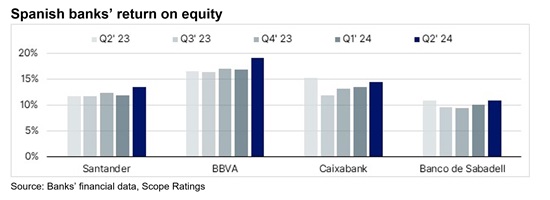Announcements
Drinks
Spanish bank quarterly: Strong domestic economy, lending growth support bank performance
Our sample of banks – BBVA, Santander, Sabadell and CaixaBank – achieved an average return on equity of 14.4 % in the second quarter, higher than the previous quarter (13.1%) thanks to the strong performance of net interest income. All four banks have revised their guidance up for full-year 2024.
“Spanish bank profitability remains robust, still supported by net interest income and peak efficiency,” said Carola Saldias, lead analyst for Spanish banks. “For the second half of the year, though, we expect NII to adjust downwards as interest rates start to decrease while deposit costs adjust more slowly.”
The largest contributor to NII continues to be repricing of loan portfolios as lending volumes, mostly consumer loans, are growing faster than expected, while the cost of deposits declined marginally. Q2 results were also supported by strong operational efficiency.
Fee and commission income is also recovering QoQ, supported by payments and wealth management products. “We expect this revenue line to continue growing in Q3 and Q4, as positive economic momentum in Spain – forecast to grow by 2.4% this year, outpacing the euro area – and seasonal consumption will help banks with a higher retail component to benefit from this positive trend,” Saldias said.
Asset-quality metrics remain strong but we expect further deterioration in Q3 and Q4 as NPLs converge to a normalised level. NPLs are stable but stage 2 loans are rising and cost-of-risk dynamics are changing. Cost of risk continues to increase QoQ for almost all banks, in some cases slightly above year-end guidance. Some banks are actively managing credit risk through portfolio sales and provisioning.
“We do not currently see sector-specific credit-quality deterioration, as is the case with commercial real estate in other EU countries since Spanish banks’ exposures are diversified across productive sectors of the economy,” Saldias said.
Spanish banks maintain an adequate level of capital, even though the buffer above regulatory requirements at our sample is still below the average of EU peers. This reflects optimisation strategies and business-model differences. The average CET 1 ratio was 12.8% for our sample, only 20bp higher than December 2023 as RWA have increased by 1.8% year-to-date.








